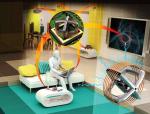What the future holds….

Imagine a future in which wireless power transfer is feasible: cell phones, household robots, mp3 players, laptop computers and other portable electronics capable of charging themselves without ever being plugged in, freeing us from that final, ubiquitous power wire. Some of these devices might not even need their bulky batteries to operate.
Various methods of transmitting power wirelessly have been known for centuries. But it wasn’t until the rise of personal electronic devices that the demand for wireless power materialized.
Perhaps the best known example is electromagnetic radiation, such as radio waves. While such radiation is excellent for wireless transmission of information, it is not feasible to use it for power transmission. Since radiation spreads in all directions, a vast majority of power would end up being wasted into free space.
One can envision using directed electromagnetic radiation, such as lasers, but this is not very practical and can even be dangerous. It requires an uninterrupted line of sight between the source and the device, as well as a sophisticated tracking mechanism when the device is mobile.
The Solution: WiTricity
Researchers at Massachusetts Institute of Technology recently demonstrated a technology that can wirelessly transfer electricity across a room, an important step toward accomplishing this vision of the future. They were able to light a 60W light bulb from a power source seven feet (more than two meters) away; there was no physical connection between the source and the appliance. The team called their invention WiTricity, short for “wireless electricity.”
The WiTricity setup consisted of two copper coils, oscillating at the same frequency and trading energy across the two meter divide via their electromagnetic field. While one of the coils was attached to a power supply, acting as the transmitter, the other one was connected to the bulb and acted as the receiver. The key to wireless power is resonance.
The key: Magnetically coupled resonance
The science behind the magic is based on the fact that two objects at the same resonant frequency can effectively exchange energy. Think of a wineglass that shatters when an opera singer hits just the right note. When the voice matches the glass’s resonant frequency—the tone you hear when you tap the glass—the glass efficiently absorbs the singer’s energy and cracks.
In any system of coupled resonators there often exists a so-called “strongly coupled” regime of operation. If one ensures to operate in that regime in a given system, the energy transfer can be very efficient. While these considerations are universal, applying to all kinds of resonances (e.g., acoustic, mechanical, electromagnetic, etc.), the MIT team focused on one particular type: magnetically coupled resonators. The team explored a system of two electromagnetic resonators coupled mostly through their magnetic fields; they were able to identify the strongly coupled regime in this system, even when the distance between them was several times larger than the sizes of the resonant objects. This way, efficient power transfer was enabled.
Magnetic coupling is particularly suitable for everyday applications because most common materials interact only very weakly with magnetic fields, so interactions with extraneous environmental objects are suppressed even further. “The fact that magnetic fields interact so weakly with biological organisms is also important for safety considerations”.

The investigated design consists of two copper coils, each a self-resonant system. One of the coils, attached to the power source, is the sending unit. Instead of irradiating the environment with electromagnetic waves, it fills the space around it with a non-radiative magnetic field oscillating at MHz frequencies. The non-radiative field mediates the power exchange with the other coil (the receiving unit), which is specially designed to resonate with the field. The resonant nature of the process ensures the strong interaction between the sending unit and the receiving unit, while the interaction with the rest of the environment is weak.
“The crucial advantage of using the non-radiative field lies in the fact that most of the power not picked up by the receiving coil remains bound to the vicinity of the sending unit, instead of being radiated into the environment and lost.”
As long as the device (eg. laptop) is in a room equipped with a source of such wireless power, it would charge automatically, without having to be plugged in. In fact, it would not even need a battery to operate inside of such a room. In the long run, this could reduce our society’s dependence on batteries, which are currently heavy and expensive.
Still a long way to go…..
At the first glance, it might sound great. But its harmful effects like cancer on humans, especially in case of high voltage transfer and questions to its efficiency still need strong answers before implementing.
However, scientists across the globe believe that “If it works and it’s safe, it will be one of the greatest achievements ever.”


Recent Comments